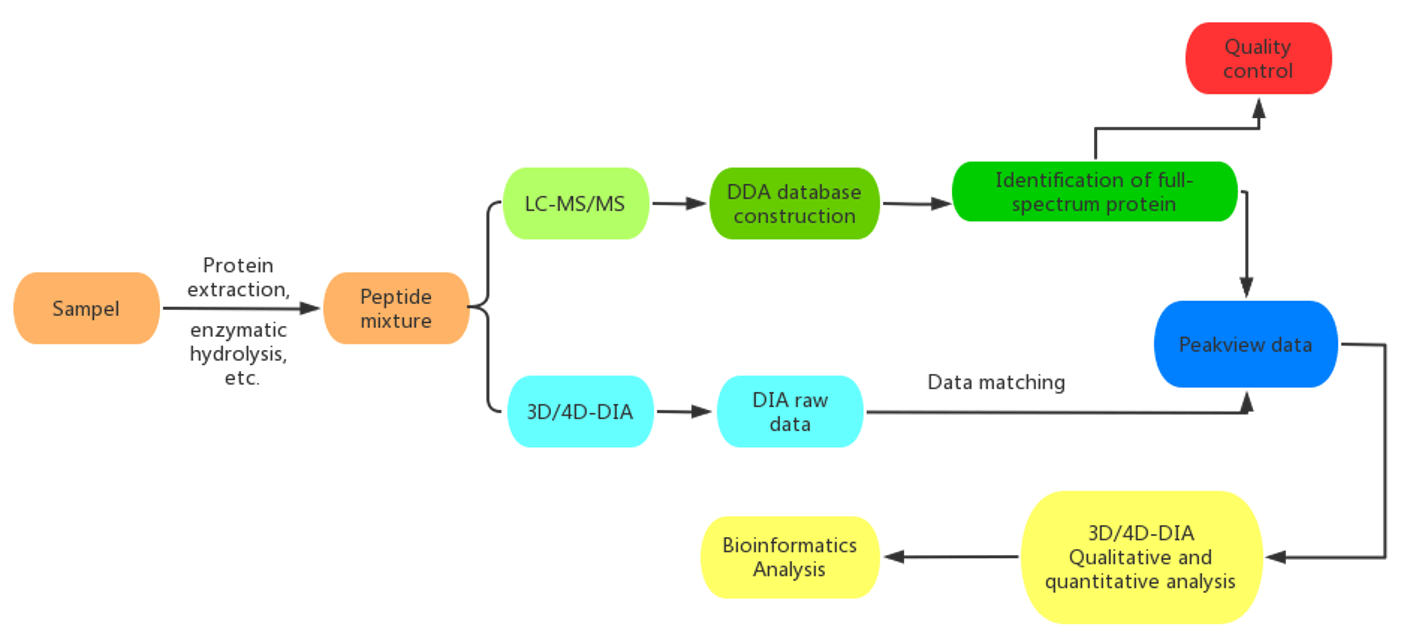Tear Proteomics Solutions
The tear film consists of the thin layer of mucus, proteins, lipids and salts that covers the entire surface of the eye. Under physiological conditions, the tear film serves five important functions: protecting the eye from debris and bacteria, lubricating the eye and eyelids, providing a smooth surface, improving the refractive power of the cornea, and providing nutrients to the eye[1].
Tear film proteomics provides powerful analytical tools for studying proteins associated with ocular diseases such as dry eye disease and meibomian gland disease. Using these tools, we can understand proper protein function in homeostasis as well as in underlying disease processes, and provide diagnostic biomarkers. The study of differential protein expression in complex biological fluids such as the tear film requires rapid, highly reproducible and accurate quantification. These requirements can be met by mass spectrometry (MS)[2].
 Tear proteome and protein network analyses for tear film characterization in dry eye and meibomian gland dysfunction[4]
Tear proteome and protein network analyses for tear film characterization in dry eye and meibomian gland dysfunction[4]
Tear proteins have also been shown to contain several hundred plasma proteins. The overlap between the two is further evidence that a number of systemic diseases may affect the eye proteins, so that we can use tear proteins to assess systemic and ocular diseases. Moreover, tear collection is rapid, safe, and non-invasive, demonstrating that it is an important tool for identifying relevant diseases.
In the last decade, advances in mass spectrometry and omics technologies have greatly improved our understanding of tear proteome, improved sensitivity and speed acquisition, confirmed various acquisition methods, and identified disease biomarkers previously lacking in the ophthalmic field. Nearly 2000 tear proteins have been reported in humans[3]. The use of MS can efficiently identify torn proteins, produce reproducible results and, more importantly, determine changes in protein numbers and post-translational modifications in microliter samples[3].
Our Tear Proteome Analysis Services
Powered by our cutting-edge technology, extensive facility, and state-of-the-art data analytics, Creative Proteomics provides deep, large-scale insights on Tear Proteome.
Based on DIA technology and 4D technology, we have launched target proteomics and discovery proteomics platforms to detect proteins and other analytes in tear samples with high throughput, helping you explore novel biomarkers and accelerate the research process for diagnosis, prognosis, and treatment of related diseases.
Our Tear Proteome Analysis Services include but are not limited to
Accuracy, depth and large-scale protein qualitative and quantitative analysis of tears.
Assess the level of PTM to characterize the biomarker and understand the function of the protein.
Biochemical pathways prospection.
Find potential candidates as biomarkers for disease.
Workfolw

Bioinformatics Analysis
| Problems to be Solved | Bioinformatics Analysis |
| Quality Assessment of Protein | SWATH Data Analysis |
| Comparison of Proteins within Different Samples | Multivariate PCA Analysis |
| Protein Statistical Analysis | Venn Diagram |
| Volcano Plot | |
| Functional Annotation | KEGG Annotation |
| GO Annotation | |
| COG Annotation | |
| Clustering Analysis | Hierarchical Clustering |
| K-Means Clustering | |
| Network Analysis | STRING Analysis |
Advantages
1. Sensitivity: detect the differences of multiple samples in low-abundance proteins.
2. Large Scale: achieve high-throughput DIA data extraction and statistical validation using our advanced protein quantitation platforms.
3. Team of Bioinformatics Experts: our biological expertise and data analytics capabilities can help dig deeper into potential information to support biomarker discovery and drug development.
4. Rich Experiences
Platform
Mass spectrometric analysis combined with statistics and bioinformatics tools
Report
A full report including all raw data, MS/MS instrument parameters and step-by-step calculations will be provided (Excel and PDF formats).
Creative Proteomics offers a broad range of cutting-edge tear proteomics services using mass spectrometry-based proteomics technologies to help you dig deeper biological information to obtain potential biomarkers and their mechanisms of action. Please contact us to know more about our platforms and services.
References:
- Jingjing You, Anna Fitzgerald, Paul J. Cozzi, Zhenjun Zhao, Peter Graham, Pamela J. Russell, Bradley J. Walsh, Mark Willcox, Ling Zhong, Valerie Wasinger, Yong Li. Post-translation modification of proteins in tears. BIOANALYSIS. 31,1853-1861 (2010)
- Jessica Yuen Wuen Ma,Ying Hon Sze,Jing Fang Bian,Thomas Chuen Lam. Critical role of mass spectrometry proteomics in tear biomarker discovery for multifactorial ocular diseases. International Journal of Molecular Medicine. 47, 5 (2021)
- Lei Zhou, Roger W. Beuerman. The power of tears: how tear proteomics research could revolutionize the clinic. Expert Review of Proteomics. 14, 189-191 (2017)
- J.Soriaa. et al. Tear proteome and protein network analyses reveal a novel pentamarker panel for tear film characterization in dry eye and meibomian gland dysfunction. Journal of Proteomics. 78. 94-112 (2013)


 4D Proteomics with Data-Independent Acquisition (DIA)
4D Proteomics with Data-Independent Acquisition (DIA)